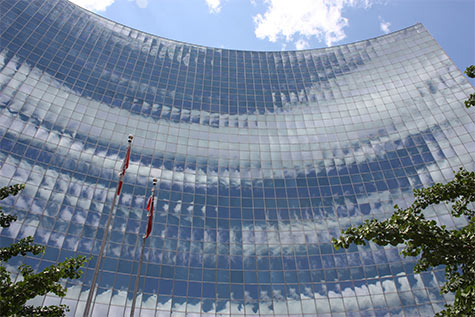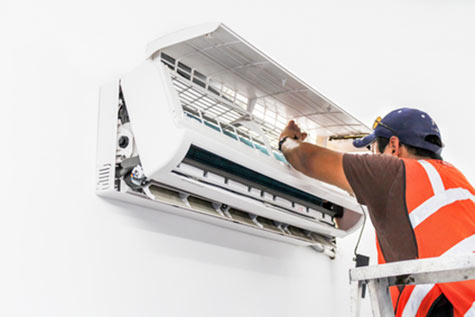Over the coming weeks we will be bringing information and advice on products, maintenance and services which will help facilities managers cut costs and improve efficiency of their air conditioning systems. Essential knowledge will also be shared on meeting and surpassing environmental and energy saving targets.
The information below applies to those businesses or public sector facilities managers who will have to plan building fit-out works, new builds and extensions to facilities, refurbishments or replacements to air con systems in the coming months. It also provides useful advice for those managing commercial buildings and wish to consider how to save on energy bills.
How to save money and energy consumption without compromising on comfort
Reducing energy consumption not only saves money, it also helps enhance corporate reputation and helps fight against climate change.
This overview of technology and plant available in 2015 helps introduce innovative, energy saving and cost-cutting assets into a new office environment. We have also kept a keen eye on improving working conditions for staff whilst having a positive impact on building operators profit margins and tenants’ expenditure.
First let’s put this in context. Where is commercial building use heading between now and the end of the decade?
By the end of 2020 around 40% of commercial floor space is expected to be air conditioned, according to the Carbon Trust. This constitutes a 4-fold increase since 1994. This is being fuelled by more intensive building use, expectation of warmer climate and demands for comfort by commercial occupants.
There should be considerable political will in favour of energy efficient products. Over half of the required reductions in carbon emissions (60% by 2050) are expected to come from increased energy efficiencies brought about by technology and innovation in buildings, product and plant.
An EU directive called the EPBD (Energy Performance of Buildings Directive) came into force back in 2006 and is designed to increase investment in energy efficiency measures. The knock-on effect in terms of UK building regulations has meant increasing pressure and challenges on those involved in the construction and refurbishment of commercial property.
What new opportunities should you be aware of as a facilities manager, procurement department or building operator?
Free Cooling
One of the most important assets to be aware of is free cooling. This helps to minimise costs in a country where it is not necessary to operate comfort cooling mechanically every day. As air conditioning can account for up to 30% of electricity consumption in a commercial building, these innovations designed to help reduce these costs means they make sound financial sense.
As increased prevalence of air conditioning continues to increase an organisations ‘summer carbon footprint’ and energy consumption shifts from being traditionally higher in the winter to now possibly being higher in the summer, free cooling should be considered where possible.
Variable speed drives
These help prevent buildings air conditioning systems from using more energy than is needed. Varying the output of a/c throughout the day, dependent on requirements, helps you save money on energy costs.
A long term view of UK Summers – Buildings built to last
As UK average annual temperatures are expected to increase by a few degrees over the course of this century, those designing and purchasing buildings need to consider the changing demands this will bring in terms of providing comfort and healthy internal environments over the buildings lifetime. Of course this has to be considered in light of the need to minimise energy use and greenhouse gas emissions. Naturally ventilated buildings are more likely to overheat more frequently in these circumstances.
Aspects which impact on your air conditionings energy usage
- Building design, layout and operation – affecting how the external environment impacts on the building interiors temperature and humidity
- What interior temperature and air quality do you require? Traditionally cooler temperatures, greater precision and more refined air quality all come at a higher cost – through greater energy consumption.
- What else do you have inside? Lighting, equipment and people all impact on how much cooling a building needs. Can the need for artificial lighting be minimised through smart design?
- The design and efficiency of the air conditioning system you intend to install.
- Control over operating times of the air conditioning system and flexibility and level of control it affords you.
- The amount of fresh air provided per person.
So the three ways of improving your buildings air conditioning performance can be grouped into one of three factors.
- Good design
- Suitable commissioning
- Effective maintenance and management
Buildings with a greater degree of free cooling in place tend to be better performing and may also be easier to operate and maintain, leading to greater occupant satisfaction and better operating costs. Videos explaining the principles of free cooling can be found here on our website.
Reusing existing ventilation during office or building re-fits
When outdated (quite possibly R22 refrigerant) air conditioning systems need replacement, they are often replaced with efficient R410 systems. Patented replacement technology can be used in many cases to reuse existing pipework, ducting and wiring. This can lead to significant savings for owners and occupants of office buildings. Partnerships can be formed between office fit-out companies and experienced air conditioning installation companies to put a replacement plan in place that is as environmentally resourceful and cost –effective as possible for the customer.
Refrigerant pipes, electrical wiring, ducting and communications wiring can often be reused. Flushing functions can be used to ensure any old R22 refrigerant is removed. So businesses still in the final planning stages of a replacement project might like to check whether the plans make full use of existing infrastructure.
Indoor and outdoor units can also be replaced whilst business continues for your customer which also minimises the impact on customers operations and productivity.
Modern, efficient replacement air conditioning systems have been proven to reduce energy requirements by up to 50%. Low CO2 emissions also protect the environment. For these reasons the refurbishment of a ventilation system can benefit from a comprehensive assessment of its current operational performance compared with what is now available in terms of technology.
This review can then identify whether an office refurbishment requires a complete system overhaul or simply the replacement of specific plant and components where more energy efficient alternatives are available. Procurement can then be carried out as cost-effectively as possible.
Ductwork – the long and short of it
As ductwork has a high embodied energy impact, it is necessary to minimise its usage so as to reduce the environmental impact inherent in it, as well as the actual financial cost of the material itself to the project.
- Considering all areas of the building which can take advantage of natural air systems rather than mechanical ventilation
- Making use of local extraction through the careful placement of plant to minimise duct runs
- Positioning air handling units as close as possible to ventilated space in order to reduce the length of ductwork
- Safely avoiding excessive numbers of fittings to reduce embodied energy, material use and financial costs
- Sealing ductwork so it has minimal leakage which can allow for reductions in plant and size of ducting
- Making use of circular ductwork where possible to minimise amount of materials required
Repair and maintenance
HVAC systems can be responsible for up to 70% of an office buildings’ energy consumption. Although this article focuses largely on air conditioning, the operation of the boiler system and provision of hot water to the facility are responsible for a large amount of this.
Therefore the regular maintenance and repairs required to maintain optimum efficiency of both hot water systems and air conditioning are essential in minimising the overall impact of HVAC on energy costs. Once air conditioning has been installed, facilities managers can familiarise themselves with fault codes to ascertain which can be remedied simply and which require a call out from a professional repair engineer.
Renovations to minimise heat gains
As sunlight, equipment, lighting and refrigeration all generate heat it is well worth performing a review of where excess heat is originating from. Low energy lighting, effective use of shading and keeping equipment at optimum efficiency all help to minimise the presence of heat.
Occupant Behaviour
Clearly the usage of the system by building occupants is a major factor in ongoing costs. Design and plant can be installed which aids the occupant to use air conditioning smartly. For example straightforward controls which help employees prevent having heating and air conditioning competing against each other. This allows for a clear ‘deadband’ – the gap in temperature between requiring air conditioning and heating to be functioning.
For more information on improving the efficiency and environmental impact of your buildings air conditioning system contact ABI on 01922 457 833 or email info@abi-fe.co.uk
We are able to advise on air con matters related to new building fit-outs, replacement systems and those required due to building refurbishments. We also have an experienced maintenance and servicing department. More information on us can be found at www.abi-fe.co.uk





